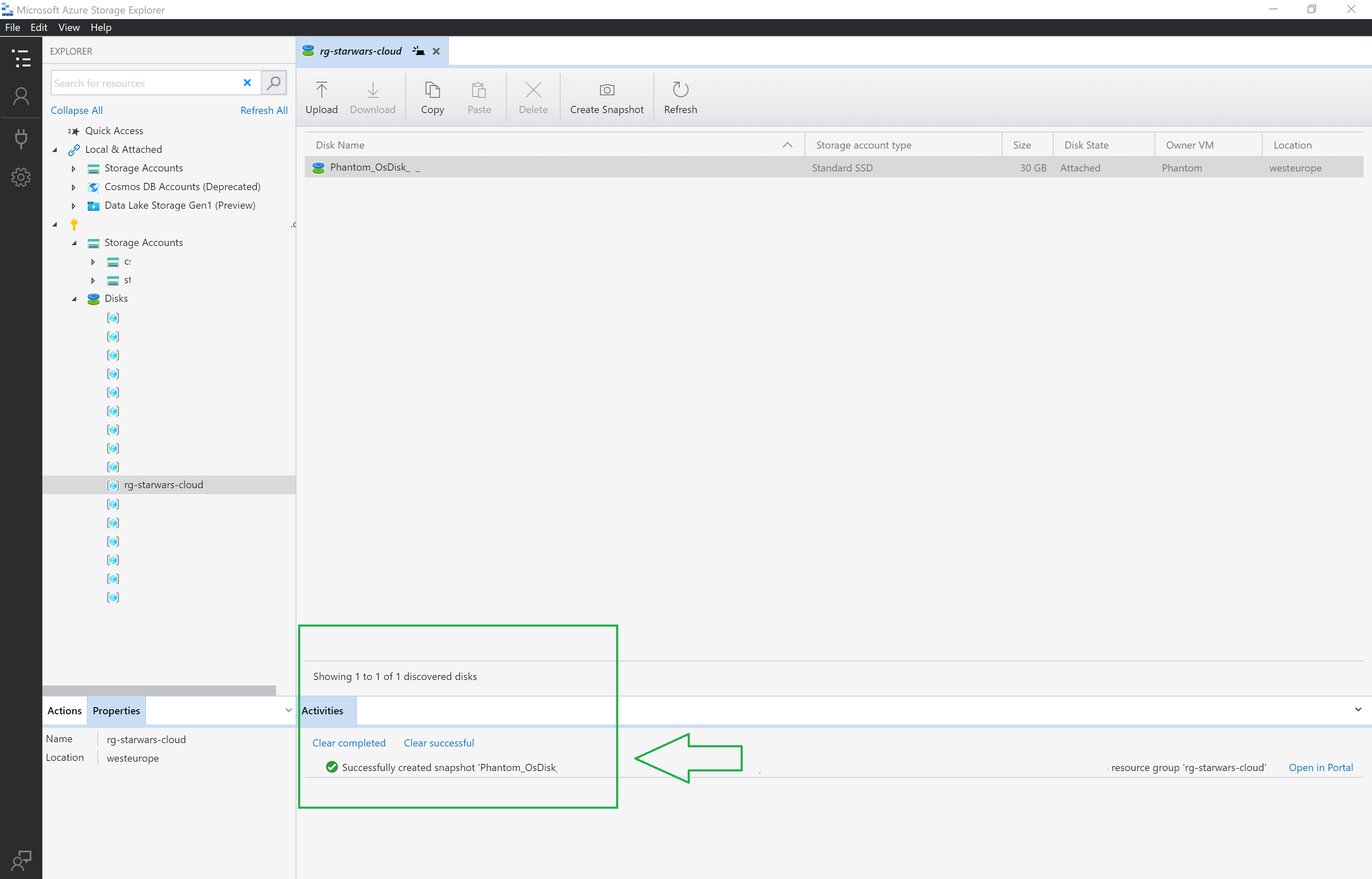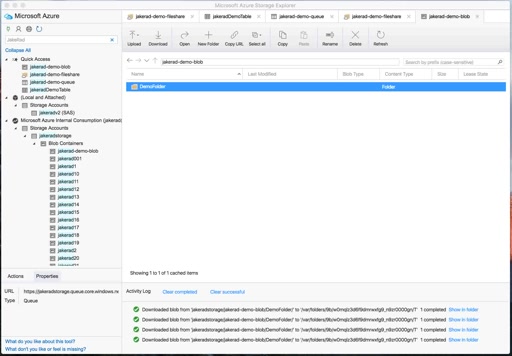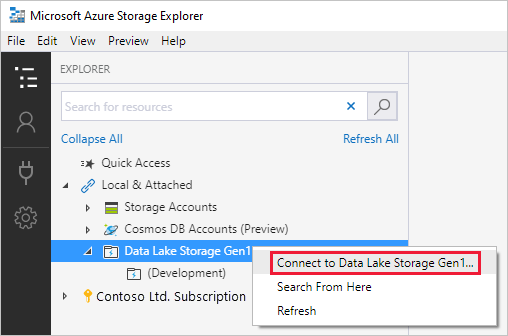I have a big plan to move all my blog websites to the cloud – to Azure. By personal choice, I prefer Microsoft Azure because I have been working mostly with Microsoft programming language like C# in .NET frameworks.
- Azure Cloud Storage Explorer Software
- Azure Storage Explorer Download App
- Azure Storage Explorer Tool
- Azure Cloud Storage Explorer App
Azure Data Explorer is a fully-managed big data analytics cloud platform and data-exploration service, developed by Microsoft, that ingests structured, semi-structured (like JSON) and unstructured data (like free-text). The service then stores this data and answers analytic ad hoc queries on it with seconds of latency. It is a full text indexing and retrieval database, including time series.
Steps to Moving My Blogs to Microsoft Azure
For many, it can be very overwhelming getting started with the cloud. Aside from the fact that there are many huge public cloud providers available, choosing a cloud provider also requires some knowledge.
Check out my top 6 favorite Azure Services.
- Easily manage the contents of your storage account with Azure Storage Explorer. Upload, download, and manage blobs, files, queues, tables, and Cosmos DB entities. Gain easy access to manage your virtual machine disks.
- Microsoft is radically simplifying cloud dev and ops in first-of-its-kind Azure Preview portal at portal.azure.com.
For example learning the basics of what cloud services are there available and how any of these modern services can help solve some of the existing technical problems. Perhaps finding out how these technologies fulfill some business requirements in organizations. Adobe reader full download mac.
The public cloud provider like Microsoft Azure offers many great services – cloud solutions from IaaS, PaaS, SaaS, FaaS, Serverless to container services. So, there a lot to choose from and each service serves its purpose! Of course, the choice of service or combination of cloud services really depend on what it is you want to build or technical problems you want to solve.
For my case, I decided to start improving and moving stuff to Azure, not just for better management, logging and analytics but also for many great technical reasons.
Currently, I do not have much extra free time these days to dedicate and to do this personal migration to cloud project full time but I started to make use of the Azure services that I can implement in my existing blogs.
For example using Azure CDN or Azure Content Delivery Network for caching images on this website to speed it up. I am also deciding to write my own CMS in Blazor or is it easier to use the .NET based CMS like Umbraco CMS. And maybe use Azure Functions for other tasks like emails etc. A big plan, a big personal project and we will see when it’s completely done, I am also in the process of moving some blog files especially images into Azure Storage BLOB containers in Azure for better storage management.
Why I want to move to the Cloud and Migrate to Azure?
Moving to the cloud are both a necessity and a challenge in our digitalization today, but it is not easy for many. It is a huge challenge for many organizations today. Who doesn’t want to go in àjour with our fast-paced modern technologies these days? I’ve had an experience working on a “migration to cloud” project that didn’t make to production because of a lot of practical reasons. Why? It is another story and lesson-learned tech talk to share!
As for me, administrating and running my website blogs in CMS (Content Management System) for the past several years (since 2010) makes it easier for content administration.
Jonah’s Fun Fact: Did you know that I’ve created by own CMS from scratch in PHP programming language? This was back then when I was learning programming in PHP.
Check out this YouTube of John Savill, Overview of Migrating to Azure – which is think is very useful and explains why it is worth considering.
Microsoft Azure Storage Explorer
So you learned about why I am motivated to learn my way as I move up to the cloud, what is this Azure Storage Explorer?
Microsoft Azure Storage Explorer is a standalone app that makes things easier for us Azure users. Especially to users who are using Azure Storage data. The Azure Storage Explorer can be installed and used on Windows, macOS, and Linux.
With this tool, users have the benefits of managing their storage like Azure Blobs, queues, tables, files, data in Azure Cosmos DB and Azure Data Lake Storage. Prevent adobe reader from opening download mac.
Users can also access virtual machine disks and manage Azure Resource Manager or classic storage accounts. Even the ability to configure cross-origin resource sharing rules.
Benefits of Managing Azure Storage with Azure Storage Explorer
- Storage accounts management for Azure subscriptions, Azure Stack, and government cloud
- Robust Security for data access using cross-origin resource sharing and shared access signature
- Work offline, online or on-premises
- Great modern and user-interface to manage all your cloud data storage
Getting Started and Learning Resources
To get started with this great storage tool, you need to download it from Microsoft website depending on the type of operating system you have.
Azure Cloud Storage Explorer Software
Learn more at https://azure.microsoft.com/en-us/updates/azure-storage-explorer/
About Author:Jonah Andersson is a Filipina-Swedish Software Developer who codes fullstack system development in C# .NET/NET Core. She currently works as a Software Developer Consultant atForefront Consultingin Sweden. Jonah is passionate about learning, developing and sharing knowledge about Microsoft Azure cloud technologies. A woman who code advocating gender equality in the tech industry through mentorship and by being role model. She also lovescreative technical writing her experience.
-->Overview
Microsoft Azure Storage Explorer is a standalone app that makes it easy to work with Azure Storage data on Windows, macOS, and Linux.
In this article, you'll learn several ways of connecting to and managing your Azure storage accounts.

Prerequisites
The following versions of Windows support Storage Explorer:
- Windows 10 (recommended)
- Windows 8
- Windows 7
For all versions of Windows, Storage Explorer requires .NET Framework 4.7.2 at a minimum.
The following versions of macOS support Storage Explorer:
- macOS 10.12 Sierra and later versions

Storage Explorer is available in the Snap Store for most common distributions of Linux. We recommend Snap Store for this installation. The Storage Explorer snap installs all of its dependencies and updates when new versions are published to the Snap Store.
For supported distributions, see the snapd installation page.
Storage Explorer requires the use of a password manager. You might have to connect to a password manager manually. You can connect Storage Explorer to your system's password manager by running the following command:
Storage Explorer is also available as a .tar.gz download. If you use the .tar.gz, you must install dependencies manually. The following distributions of Linux support .tar.gz installation:
- Ubuntu 20.04 x64
- Ubuntu 18.04 x64
- Ubuntu 16.04 x64
The .tar.gz installation might work on other distributions, but only these listed ones are officially supported.
For more help installing Storage Explorer on Linux, see Linux dependencies in the Azure Storage Explorer troubleshooting guide.
Download and install
To download and install Storage Explorer, see Azure Storage Explorer.
Adobe InDesign is the industry-leading layout and page design software for print and digital media. Create beautiful graphic designs with typography from the world’s top foundries and imagery from Adobe Stock. Quickly share content and feedback in PDF. Easily manage production with Adobe Experience Manager. Adobe acrobat indesign cs3. Adobe InDesign The industry-leading page design and layout app has everything you need to craft elegant layouts for print and digital media including posters, books, digital magazines, eBooks, interactive PDFs, and more. InDesign integrates seamlessly with Adobe Photoshop, XD, Premiere Pro, and Illustrator. Go ahead, add an eye-catching cover. Design for your readers. Prepare your eBook for publishing with versatile ePub formats supported by Apple iBooks, Kindle, and more. The OCR (Optical Character Recognition) software that Acrobat uses to convert your design into a working form can only see clear, legible type and high-contrasting elements. The best way to ensure that your design is readable is to stick to a white background with black type for any info that needs to be converted.
Connect to a storage account or service
Storage Explorer provides several ways to connect to Azure resources:
Sign in to Azure
Note
To fully access resources after you sign in, Storage Explorer requires both management (Azure Resource Manager) and data layer permissions. This means that you need Azure Active Directory (Azure AD) permissions to access your storage account, the containers in the account, and the data in the containers. If you have permissions only at the data layer, consider choosing the Sign in using Azure Active Directory (Azure AD) option when attaching to a resource. For more information about the specific permissions Storage Explorer requires, see the Azure Storage Explorer troubleshooting guide.
In Storage Explorer, select View > Account Management or select the Manage Accounts button.
ACCOUNT MANAGEMENT now displays all the Azure accounts you're signed in to. To connect to another account, select Add an account...
The Connect to Azure Storage dialog opens. In the Select Resource panel, select Subscription.
In the Select Azure Environment panel, select an Azure environment to sign in to. You can sign in to global Azure, a national cloud or an Azure Stack instance. Then select Next.
Tip
For more information about Azure Stack, see Connect Storage Explorer to an Azure Stack subscription or storage account.
Storage Explorer will open a webpage for you to sign in.
After you successfully sign in with an Azure account, the account and the Azure subscriptions associated with that account appear under ACCOUNT MANAGEMENT. Select the Azure subscriptions that you want to work with, and then select Apply.
EXPLORER displays the storage accounts associated with the selected Azure subscriptions.
Attach to an individual resource
Storage Explorer lets you connect to individual resources, such as an Azure Data Lake Storage Gen2 container, using various authentication methods. Some authentication methods are only supported for certain resource types.
| Resource type | Azure AD | Account Name and Key | Shared Access Signature (SAS) | Public (anonymous) |
|---|---|---|---|---|
| Storage accounts | Yes | Yes | Yes (connection string or URL) | No |
| Blob containers | Yes | No | Yes (URL) | Yes |
| Gen2 containers | Yes | No | Yes (URL) | Yes |
| Gen2 directories | Yes | No | Yes (URL) | Yes |
| File shares | No | No | Yes (URL) | No |
| Queues | Yes | No | Yes (URL) | No |
| Tables | No | No | Yes (URL) | No |
Storage Explorer can also connect to a local storage emulator using the emulator's configured ports.
To connect to an individual resource, select the Connect button in the left-hand toolbar. Then follow the instructions for the resource type you want to connect to.
When a connection to a storage account is successfully added, a new tree node will appear under Local & Attached > Storage Accounts.
For other resource types, a new node is added under Local & Attached > Storage Accounts > (Attached Containers). The node will appear under a group node matching its type. For example, a new connection to an Azure Data Lake Storage Gen2 container will appear under Blob Containers.
If Storage Explorer couldn't add your connection, or if you can't access your data after successfully adding the connection, see the Azure Storage Explorer troubleshooting guide.
The following sections describe the different authentication methods you can use to connect to individual resources.
Azure AD
Storage Explorer can use your Azure account to connect to the following resource types:
- Blob containers
- Azure Data Lake Storage Gen2 containers
- Azure Data Lake Storage Gen2 directories
- Queues
Azure AD is the preferred option if you have data layer access to your resource but no management layer access.
- Sign in to at least one Azure account using the steps described above.
- In the Select Resource panel of the Connect to Azure Storage dialog, select Blob container, ADLS Gen2 container, or Queue.
- Select Sign in using Azure Active Directory (Azure AD) and select Next.
- Select an Azure account and tenant. The account and tenant must have access to the Storage resource you want to attach to. Select Next.
- Enter a display name for your connection and the URL of the resource. Select Next.
- Review your connection information in the Summary panel. If the connection information is correct, select Connect.
Account name and key
Storage Explorer can connect to a storage account using the storage account's name and key.
You can find your account keys in the Azure portal. Open your storage account page and select Settings > Access keys.
- In the Select Resource panel of the Connect to Azure Storage dialog, select Storage account.
- Select Account name and key and select Next.
- Enter a display name for your connection, the name of the account, and one of the account keys. Select the appropriate Azure environment. Select Next.
- Review your connection information in the Summary panel. If the connection information is correct, select Connect.
Azure Storage Explorer Download App
Shared access signature (SAS) connection string
Storage Explorer can connect to a storage account using a connection string with a Shared Access Signature (SAS). A SAS connection string looks like this:
- In the Select Resource panel of the Connect to Azure Storage dialog, select Storage account.
- Select Shared access signature (SAS) and select Next.
- Enter a display name for your connection and the SAS connection string for the storage account. Select Next.
- Review your connection information in the Summary panel. If the connection information is correct, select Connect.
Shared access signature (SAS) URL
Storage Explorer can connect to the following resource types using a SAS URI:
- Blob container
- Azure Data Lake Storage Gen2 container or directory
- File share
- Queue
- Table
A SAS URI looks like this:
- In the Select Resource panel of the Connect to Azure Storage dialog, select the resource you want to connect to.
- Select Shared access signature (SAS) and select Next.
- Enter a display name for your connection and the SAS URI for the resource. Select Next.
- Review your connection information in the Summary panel. If the connection information is correct, select Connect.
Local storage emulator
Storage Explorer can connect to an Azure Storage emulator. Currently, there are two supported emulators:
- Azure Storage Emulator (Windows only)
- Azurite (Windows, macOS, or Linux)
If your emulator is listening on the default ports, you can use the Local & Attached > Storage Accounts > Emulator - Default Ports node to access your emulator.
If you want to use a different name for your connection, or if your emulator isn't running on the default ports:
Start your emulator.
Important
Storage Explorer doesn't automatically start your emulator. You must start it manually.
In the Select Resource panel of the Connect to Azure Storage dialog, select Local storage emulator.
Enter a display name for your connection and the port number for each emulated service you want to use. If you don't want to use to a service, leave the corresponding port blank. Select Next.
Review your connection information in the Summary panel. If the connection information is correct, select Connect.
Connect to Azure Cosmos DB
Storage Explorer also supports connecting to Azure Cosmos DB resources.
Connect to an Azure Cosmos DB account by using a connection string
Instead of managing Azure Cosmos DB accounts through an Azure subscription, you can connect to Azure Cosmos DB by using a connection string. To connect, follow these steps:
Under EXPLORER, expand Local & Attached, right-click Cosmos DB Accounts, and select Connect to Azure Cosmos DB.
Select the Azure Cosmos DB API, enter your Connection String data, and then select OK to connect the Azure Cosmos DB account. For information about how to retrieve the connection string, see Manage an Azure Cosmos account.
Connect to Azure Data Lake Store by URI
You can access a resource that's not in your subscription. You need someone who has access to that resource to give you the resource URI. After you sign in, connect to Data Lake Store by using the URI. To connect, follow these steps:
Under EXPLORER, expand Local & Attached.
Right-click Data Lake Storage Gen1, and select Connect to Data Lake Storage Gen1.
Enter the URI, and then select OK. Your Data Lake Store appears under Data Lake Storage.
This example uses Data Lake Storage Gen1. Azure Data Lake Storage Gen2 is now available. For more information, see What is Azure Data Lake Storage Gen1.
Generate a shared access signature in Storage Explorer
Account level shared access signature
Right-click the storage account you want share, and then select Get Shared Access Signature.
In Shared Access Signature, specify the time frame and permissions you want for the account, and then select Create.
Copy either the Connection string or the raw Query string to your clipboard.

Azure Storage Explorer Tool
Service level shared access signature
You can get a shared access signature at the service level. For more information, see Get the SAS for a blob container.
Search for storage accounts
To find a storage resource, you can search in the EXPLORER pane.
As you enter text in the search box, Storage Explorer displays all resources that match the search value you've entered up to that point. This example shows a search for endpoints:
Note
To speed up your search, use Account Management to deselect any subscriptions that don't contain the item you're searching for. You can also right-click a node and select Search From Here to start searching from a specific node.
Azure Cloud Storage Explorer App
Next steps
